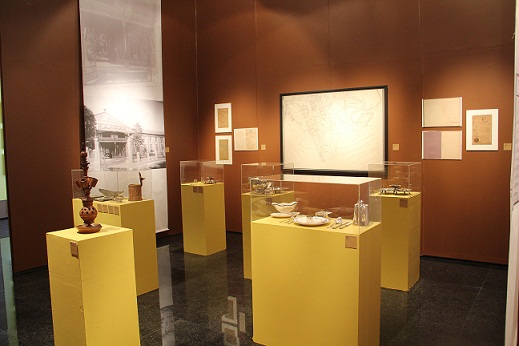By NORMAN SISON
FIRST and foremost, the museum exhibit is about the corporate history of a Spanish cigar company that brought Philippine cigars to the world. But the exhibit about Compañia General de Tabacos de Filipinas can also be seen as a reminiscing into the glory days when Philippine cigars rivaled Cuban stogies.
Among many other items on display at the ground floor of the Ayala Museum is a 19th-century wooden cigar holder that resembles a candelabra. On another display stand are two tobacco containers, an ornate cigar tray, and a cigar lighter and cutter set — all made of silver — dating back to the 19th and early 20th centuries.
Visitors wonder at the label designs of cigarillo brands that seem like artwork compared to today’s cigarette packaging on which printed health warnings are prominent.
Compañia General de Tabacos de Filipinas — better known by its nickname, Tabacalera — was founded on November 26, 1881, with the sole purpose of taking over the Spanish colonial government’s 100-year monopoly on tobacco, which was abolished that year.
With an initial capital of 75 million pesetas, Tabacalera bought the government’s cigar factories and plantations, standardized quality and exported Philippine cigars — better known as “Manila cigars” — to Europe and the rest of the world.
In 1886, famed British writer Rudyard Kipling devoted a stanza to the Philippine cigar in his poem, “The Betrothed”:
Open the cigar box — let me consider a while
Here is a mild Manila — there is a wifely smile
 In the following decades, Tabacalera expanded into other businesses such as abaca, cellulose, coconut, copra, cotton, hemp, insurance, liquor, rice, shipping and sugar. At its peak, in the 1940s, it was one of the largest conglomerates in the Philippines — with about 27,000 employees. For a time, it accounted for up to 30 percent of the Philippine government’s total tax revenue.
In the following decades, Tabacalera expanded into other businesses such as abaca, cellulose, coconut, copra, cotton, hemp, insurance, liquor, rice, shipping and sugar. At its peak, in the 1940s, it was one of the largest conglomerates in the Philippines — with about 27,000 employees. For a time, it accounted for up to 30 percent of the Philippine government’s total tax revenue.
“It does not seem possible to write about the recent economic history of the Philippines without taking into account the work of the Compañia General de Tabacos de Filipinas,” says the exhibit’s curator, Martin Rodrigo, a professor of history at the University Pompeu Fabra in Barcelona, Spain. The Spanish embassy in Manila organized the exhibit, which opened April 21 and will be on until July 6, in line with efforts to rekindle ties between Spain and the Philippines.
From the 1950s to the 1990s, changing fortunes prompted Tabacalera to sell off its businesses, including its famed cigar company, La Flor de la Isabela. It then went through a series of foreign acquisitions from 1997 to 2007. Today, it is a Dutch company known as CDF International.
Little traces of its 100-year existence remain today. A 15-foot long solid wood panel, on which Tabacalera’s seal is carved, adorns the lobby of supermarket chain Puregold’s Manila headquarters on Romualdez Street, where Tabacalera once had its central office.
“What surprised me most, when I started research on Tabacalera, is that the company was so big but there are only very few books about it,” says Spanish professor Marcal Sanmarti, who teaches at Ateneo de Manila University.
However, Tabacalera’s impact can still be felt to this day.
For one, its expansion into sugar resulted in the acquisition of a 6,400-hectare plantation in Tarlac province, Hacienda Luisita. In 1958, the plantation was sold to the Cojuangco clan because of the communist Huk insurgency. Generations later, worker unrest in the hacienda would hound the Philippine presidencies of Cojuangco descendant Corazon Aquino and her son, President Benigno Aquino III.
Perhaps Tabacalera’s most lasting contribution is a collection of books on Filipiniana. What makes it more interesting is that much of it was due to a Spanish scholar and bibliographer who was once a nemesis of Philippine national hero Jose Rizal.
A conservative, Wenceslao Emilio Retana y Gamboa (1862-1924) countered the views of Rizal and his fellow reformists that were expressed in the publication La Solidaridad. But Retana also had a scholarly bent. He wrote books and articles about the Philippines and its people — and collected books on Filipiniana.
Tabacalera started collecting Filipiniana in 1883 and, in 1900, bought Retana’s collection, consisting of 2,697 titles. Retana was hired by Tabacalera to guide its book acquisition.
Upon Retana’s recommendation, Tabacalera sold its collection — totaling 4,623 titles — to the US colonial government in 1913 for only P200,000. Of it, only 1,404 survived the 1945 Battle of Manila. Today, it forms the core of the National Library’s Filipiniana collection.
However, it largely remains to be discovered by Filipinos because the books were written in Spanish, a language that the Spanish colonial government didn’t teach the natives to prevent revolts.
Spanish was done away with as an official Philippine language by the 1987 Constitution. But some Filipino historians now encourage returning the language as a college course, citing it as a missing link to getting a full understanding of the nation’s past because volumes of historical documents are in Spanish.
The point of the Tabacalera exhibit is that the company’s history is also as much about the Philippines as it is about Spain — and that chapter may even chart the future.
Says Ambassador Jorge Domecq of Spain: “Although Spanish cultural activities are inclined to offer a contemporary and innovative image of the diverse cultural and artistic scene, sometimes we cannot avoid taking a look at the past, drawing from it figures, people or events that made a difference and contributed to set up the course of history.”
(VERA Files is put out by veteran journalists taking a deeper look at current issues. Vera is Latin for “true.”)

